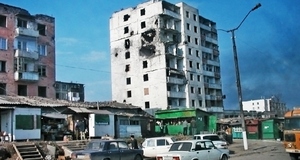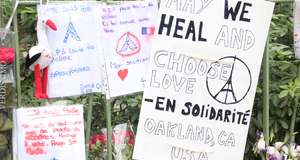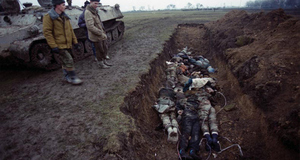Featured Article:Examining the Radicalization of Chechen Separatists During the Resistance Movement
By
2010, Vol. 2 No. 02 | pg. 2/2 | « The connection between Al Qaeda and the foreign fighters was exaggerated by the Putin administration, who following September 11th, wanted to find common ground with the new Bush administration. The Russians proposed that Khattab was working directly for Al Qaeda after US intelligence discovered his name on a document in Afghanistan linking him to Al Qaeda. However, in reality the document was just a list of Afghan foreign fighters (Moore & Tumelty, 2008, para. 420). Khattab had ideological differences with Al Qaeda and they saw him as uncooperative with their agenda. While it is true that there were some fighters in Chechnya that had links to Al Qaeda, most fighters had fixed themselves to Khattab’s strict agenda and did not deviate from it. Surprisingly, Khattab sought to regulate the number of foreign fighters coming to Chechnya after the beginning of the second war, as many were poorly trained and could drain vital resources. However, some foreign fighters did eventually become apart of Al Qaeda, including two of the September 11th hijackers (Moore & Tumelty, 2008, para. 423). During the Second Chechen War, it became clear the methods of the Chechen fighters had become much more extreme compared to the first, utilizing suicide attacks and hostage taking. In all of the four major terrorist incidents during the second war, the involvement of Arab Muslims has been confirmed. However, their involvement was largely seen as a way to attract financial support from the Middle East, and the Chechen fighters were the ones responsible for the implementation and planning of the attacks. Although foreign fighters did play a role in radicalization of the Chechens through raising funds and providing training, the connection between them has proven to be less than alleged by the Russian government and other intellectuals. Moore and Tumelty (2008) state, “the adoption of comparatively extreme methods during the second war is symptomatic of the changing nature of the indigenous resistance and the society of which it is a product, as opposed to increasing Arab influence” (p. 425). Ineffectiveness of the Chechen LeadershipThe last school of thought concerning the radicalization of the Chechens points to the ineffectiveness of the Chechen authorities and the intra-Chechen conflict that ensued after the first war. Following the collapse of the Soviet Union, there was a power vacuum in the North Caucasus in which no stable authority was able to govern effectively. By the end of the First Chechen War in 1996, it was apparent that an intra-elite struggle for power was developing between the newly elected moderate president Aslan Maskhadov and other extremist commanders such as Basaev and Khattab. Not only did Maskhadov face a power struggle, but he was left with the reconstruction of Chechnya almost entirely. The president was loosing credibility as Basaev had been gaining power and was allied with a majority of the Islamists. He was also unable to disarm the militant groups following the end of the first war and so they continued to take hostages for ransom.According to Sagramoso (2007), the inability of Maskhadov to achieve the “monopoly of the legitimate use of force in a territory”, a key condition to achieve statehood, resulted in the withdrawal of many international organizations from Chechnya, further deteriorating the post-war environment (p. 97). This inability led to the split between Islamist fundamentalists allied with Basaev, and separatists allied with Maskhadov. Young Chechens preferred Basaev’s simple religious message to Maskhadov’s practices based in secular customary law. Ensuing, was a generational division between those brought up under the Soviet Union and those born after 1980 (Moore & Tumelty, 2008, para. 415). Fearing a civil war, Hughes (2007) believes that Maskhadov did not confront Basaev but stood by as they gained more power (p. 102). This incapacity to reconcile between the two Chechen groups led to the popularity of Basaev and Khattab and their extremist tactics. AnalysisAfter exploring the many variables affecting the radicalization of the Chechen resistance movement, it has become clear that it did not evolve solely out of Russian aggression during the First Chechen War, as some scholars contend. It is evident that the relationship that developed centuries ago between Islam and Chechen nationalism became increasingly stronger as Russian brutality occurred during the 1944 deportation and the Soviet years of religious oppression. This relationship was then exploited by warlords trying to garner support for a more extreme resistance movement and Islamic slogans were used to convince the civilian population. Hertog’s (2005) analysis of the politicization of Islam is effective in proving this connection, even though the number of Chechens who went along with the rationale of the warlords was fewer than originally thought. The politicization of Islam happened recently and therefore was not something already a part of Chechnya, but rather grew out of the conflict. The connection between terrorist groups and the Chechen extremists has also been less close then thought, although it is clear that foreign fighters did play a role, albeit a minor one, in the training of Chechens who had already been carried away with the extremist movement. Thus, the role of the foreign fighters was more supportive than a direct cause in the radicalization. Hughes’ examination of the intra-Chechen struggle has also proved to be an important factor in the popularity of the extremist movement. The other camp allied with Maskhadov was unable to control the movement and he was inevitably blamed for the failure to reconstruct the republic, leading to the outbreak of the Second War. This factor has also been confirmed to play a lesser role, as it led to the popularity of extremist views but was not a defining factor that caused radicalization. ConclusionThe radicalization of the Chechen resistance movement was directly instigated by the politicization of Islam and antagonism from Russian governance, while being supported by the presence of foreign fighters and the ineffectiveness of the Chechen leadership. From this analysis, it is clear that radicalization was a gradual process, but one that involved many different factors that transformed the separatist conflict into jihad. The two hundred year long history of brutality under Russian rule and intertwinement of Islam and Chechen national identity allowed warlords to amass support in their struggle against Russia. Foreign fighters in Afghanistan found sympathy in the Chechen struggle and relocated there to assist in the training of fighters and the channeling of funds from the Middle East. Although some of the foreign fighters were affiliated with Al Qaeda, the terrorist organization was not responsible for the implantation and planning of the conflict. The incapacity of the Chechen leadership to govern led to the further support for the extremists, and ultimately closed the door in Chechen independence forever. ReferencesCampana, A. (2006). The Effects of War on the Chechen National Identity Construction. National Identities, 129-148. Cherkasov, A. & Lokshina, T. (2005). Chechnya: 10 Years of Armed Conflict. Helsinki Monitor 2005 no. 2, 143-149. Coppieters, B. (2003). Secession and war: a moral analysis of the Russian-Chechen conflict. Central Asian Survey, 22(4), 377-404. de Waal, T. (2004). A War of Unintended Consequences. Index on Censorship, 4, 54-63. Hertog, K. (2005). A Self-fulfilling Prophecy: The Seeds of Islamic Radicalization in Chechnya. Religion, State, & Society, 33(3), 239-252. Hughes, J. (2007). Chechnya: From Nationalism to Jihad. Philedelphia: University of Pennsylvania Press. Kramer, M. (2005). Guerilla Warfare, Counterinsurgency and Terrorism in the North Caucasus: The Military Dimension of the Russian-Chechen Conflict. Europe-Asia Studies, 57(2), 209-290. Moore, C. & Tumelty, P. (2008). Foreign Fighters and the Case of Chechnya: A Critical Assessment. Studies in Conflict Terrorism, 31:5, 412-433. Radu, M. (2004). Russia’s Problem: The Chechens or Islamic Terrorists? Society, 10-11. Sagramoso, D. (2007). Violence and Conflict in the Russian North Caucasus. International Affairs, 83(4), 681-705. Souleimanov, E. (2005). Chechnya, Wahhabism and the Invasion of Dagestan. Middle East Review of International Affairs, 9:4, 48-71. Ware, R.(2009). Chechenization: Ironies and Intricacies. Brown Journal of World Affairs, 15(2), 157-169. Suggested Reading from Inquiries Journal
Inquiries Journal provides undergraduate and graduate students around the world a platform for the wide dissemination of academic work over a range of core disciplines. Representing the work of students from hundreds of institutions around the globe, Inquiries Journal's large database of academic articles is completely free. Learn more | Blog | Submit Latest in International Affairs |


















